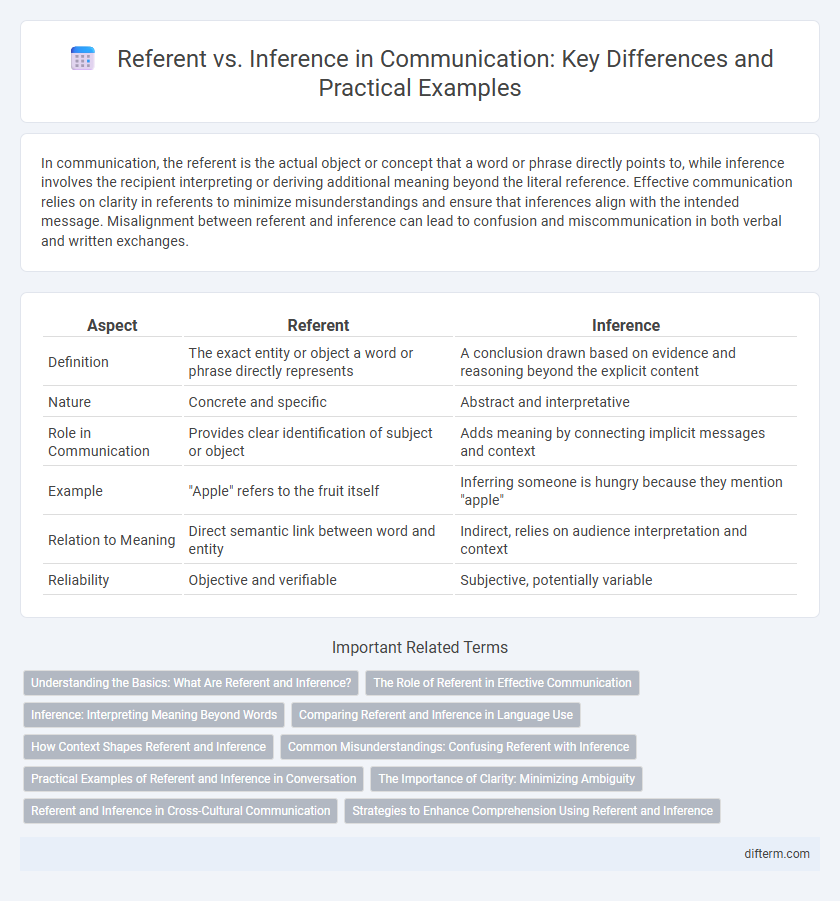In communication, the referent is the actual object or concept that a word or phrase directly points to, while inference involves the recipient interpreting or deriving additional meaning beyond the literal reference. Effective communication relies on clarity in referents to minimize misunderstandings and ensure that inferences align with the intended message. Misalignment between referent and inference can lead to confusion and miscommunication in both verbal and written exchanges.
Table of Comparison
| Aspect | Referent | Inference |
|---|---|---|
| Definition | The exact entity or object a word or phrase directly represents | A conclusion drawn based on evidence and reasoning beyond the explicit content |
| Nature | Concrete and specific | Abstract and interpretative |
| Role in Communication | Provides clear identification of subject or object | Adds meaning by connecting implicit messages and context |
| Example | "Apple" refers to the fruit itself | Inferring someone is hungry because they mention "apple" |
| Relation to Meaning | Direct semantic link between word and entity | Indirect, relies on audience interpretation and context |
| Reliability | Objective and verifiable | Subjective, potentially variable |
Understanding the Basics: What Are Referent and Inference?
Referent in communication refers to the actual object, concept, or event that a word or phrase denotes, providing a direct anchor for meaning. Inference involves the cognitive process by which a listener or reader derives implied meaning from context, beyond the explicit content. Understanding these fundamentals enhances clarity and effectiveness in interpreting messages within various communication settings.
The Role of Referent in Effective Communication
The role of the referent in effective communication is crucial as it provides a clear and specific entity that the message is about, ensuring that the receiver accurately understands the subject of discourse. Precise identification of the referent minimizes ambiguity and enhances transparency, allowing for more efficient information exchange. By establishing a concrete referent, communicators enable the listener to construct appropriate inferences, leading to coherent and meaningful interactions.
Inference: Interpreting Meaning Beyond Words
Inference in communication involves interpreting meaning beyond the literal words spoken or written, relying on context, tone, and shared knowledge. It enables listeners to draw conclusions and grasp implied messages, which are essential for effective understanding and interaction. Accurate inference reduces miscommunication by bridging gaps between explicit language and underlying intent.
Comparing Referent and Inference in Language Use
Referent in language refers to the actual object, person, or concept to which a word or phrase directly points, while inference involves the mental process of deriving meaning beyond the explicit referent based on context and prior knowledge. Effective communication relies on the listener's ability to correctly identify the referent and accurately infer implied meanings to ensure understanding. Differences between referent and inference highlight how literal and contextual cues interplay in semantic interpretation and pragmatic language use.
How Context Shapes Referent and Inference
Context profoundly influences the identification of a referent by narrowing possible interpretations based on situational cues, speaker intent, and shared knowledge between interlocutors. Inference relies on these contextual signals to fill gaps, enabling listeners to derive meaning beyond explicit statements through pragmatic reasoning. Effective communication hinges on the dynamic interplay between referent resolution and inferential processes, both shaped by cultural norms, discourse history, and environmental factors.
Common Misunderstandings: Confusing Referent with Inference
Confusing referent with inference often leads to misinterpretations in communication, as a referent is the specific entity or concept a word denotes, while inference is the meaning derived by the listener based on context and prior knowledge. Many misunderstand the referent as the inferred meaning, causing ambiguity and ineffective message transmission. Clear distinction between the explicit referent and the implicit inference is crucial for precise communication and avoiding semantic errors.
Practical Examples of Referent and Inference in Conversation
In conversation, a referent is the specific object or concept a speaker directly mentions, such as saying "the red book" to identify a particular item on a table. Inference occurs when the listener deduces meaning beyond the explicit words, like understanding "Can you pass it?" refers to the red book without it being named again. Practical examples include referring to a person by name (referent) while the listener infers the implied request or emotion behind the statement (inference) based on context and shared knowledge.
The Importance of Clarity: Minimizing Ambiguity
Clear communication hinges on precise referents to avoid misinterpretation and ensure the message is correctly understood. Ambiguity in reference forces listeners to rely on inference, which can lead to varied and unintended meanings. Prioritizing explicit referents reduces confusion and enhances the effectiveness of information transfer in both verbal and written exchanges.
Referent and Inference in Cross-Cultural Communication
Referents in cross-cultural communication are the specific objects, ideas, or concepts that words or phrases directly denote, varying significantly across different cultural contexts. Inferences involve the interpretations or implied meanings recipients derive beyond the explicit referent, influenced by cultural norms, values, and shared experiences. Effective communication requires awareness of how diverse cultural backgrounds shape referents and guide inferences, preventing misunderstandings and fostering clearer intercultural exchanges.
Strategies to Enhance Comprehension Using Referent and Inference
Effective communication strategies enhance comprehension by clearly establishing the referent, which anchors meaning to specific entities or concepts within the discourse. Encouraging active inference helps listeners fill gaps by leveraging contextual clues and prior knowledge, leading to deeper understanding. Integrating visual aids and reiterating key points solidifies the connection between explicit referents and inferred meanings, optimizing message clarity.
referent vs inference Infographic

 difterm.com
difterm.com